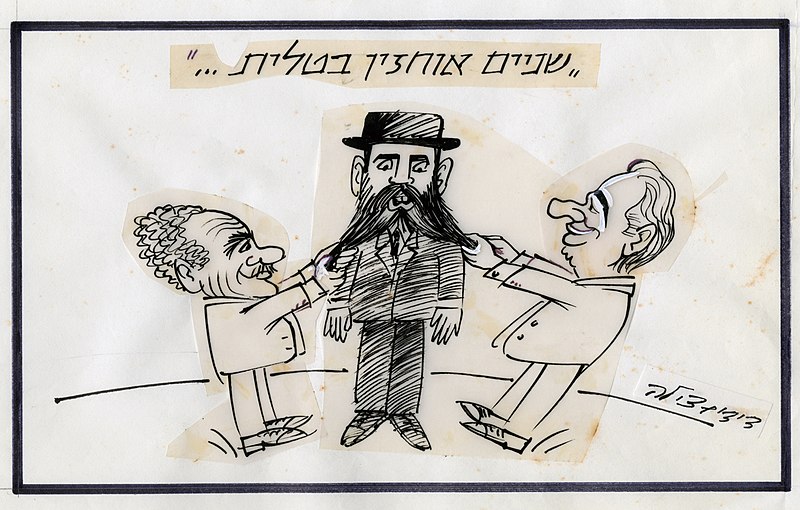Welcome to the Mishnah
You are about to enter the world of the Mishnah. So what is Mishnah? How do you find what you're looking for in it? Why might it be important to you?
In this guided experience, you will have the opportunity to go on a tour of the Mishnah using Sefaria's tools.
As you move through each section, write your answers to the questions and notes on a Google doc, on a piece of paper, or by sketchnoting your responses.
Just the Facts
First, some facts about the Mishnah.
- It was compiled at the end of the second century CE
- It is a foundational work of the Oral Torah. (Oral Torah refers to works compiled after the completion of the Hebrew Bible)
- It was edited by Rabbi Yehudah HaNasi (Judah the Prince)
- It has its own structure. Watch the GIF below to see how to open to Mishnah Megillah 4:1.

Notice that the name of the seder (order) is "Moed", the masechet (tractate) is "Megillah", the perek (chapter) is 4 and the mishnah is 1.
- Look on the table of contents for the Mishnah. How many sederim are there? How many masechtot? (Did you notice 1 seder, many sederim, 1 masechet, many masechtot?)
Jumping In - Mishnah #1
To really understand what the Mishnah is, you have to jump in and look inside.
The first Mishnah is Mishnah Berakhot 1:1. If you were to say it aloud, you would say "Masechet Berakhot, Perek 1, Mishnah 1. Open the Mishnah by clicking from the Mishnah table of contents. Read the Mishnah and answer the questions below. Note: There may be several terms and concepts in this Mishnah that you have never heard of. Don't worry about that. We are trying to figure out what the Mishnah is and not concerned at this point about understanding everything included in it.
- What question is asked in the Mishnah?
- What names are mentioned?
- How many opinions are there?
- Is the question answered?
Takeaway from Mishnah #1
Although we can't generalize about the entire Mishnah from one example, we can begin to have some opinions about what it is.
First, we see that the Mishnah sometimes talks about religious issues, such as when is the proper time to say the Shema prayer.
- What else did you notice about the subject that the rabbis were discussing?
Next, the Mishnah includes disagreements, arguments, or discussions between rabbis. This Mishnah includes a discussion between several rabbis who all had different opinions about the answer to the question.
- What were your observations about the discussion in this Mishnah?
Finally, we noticed that no final answer to the question was given. If someone wanted to know when to say the evening Shema, they wouldn't know from reading this Mishnah only.
- If you didn't learn the answer to the question from the Mishnah, what did you learn?
In Israel, every morning at 6am, one radio station plays the following reading of the Shema. The reader is Moshe Hovav. He is known for his clear pronunciation of the words. Hovav began working at the radio station in 1951 and today, more than 30 years after his death, his recording is still being played. Listen to the recording. Why do you think they have used the same recording for almost 70 years? If you would like, record your own version. You can choose your own music for the introduction.
Mishnah #2
Now that we have looked at one Mishnah, let's look at another and see what else we can figure out about the Mishnah.
Open to Mishnah Bava Metzia 1:1 and answer the questions below.
- What is the question asked in the Mishnah?
- What names are mentioned?
- What is the answer to the question?
Takeaway from Mishnah #2
Now that we have read a second Mishnah, we see that it discusses topics other than prayer. It also discusses problems that people have when they live in a community together. These problems might not seem like "religious" problems and, yet, they are discussed by the rabbis of the Mishnah.
- Why do you think the rabbis are interested in these types of questions? Look at Deuteronomy 22:1. What does it show you about the Torah's concern for returning lost property?
We also see from this Mishnah that the rabbis aren't always arguing and that they sometimes give an answer to a question.
This Mishnah is so well known that an Israeli political cartoon was drawn based on the first three words. Do you recognize any of the people in the cartoon?

Cyla Menusy עברית: צילה מנוסי, Menusy009, CC BY-SA 3.0
Mishnah #3
And now for the final Mishnah of our trip through the Mishnah. This time, let's open it a different way. You can type Mishnah Avot 1:12 into the search bar and click "enter". (Type it exactly as it is written) Read the Mishnah and answer the questions below.
- What topic is being discussed?
- What names are mentioned?
- What is the message that the Mishnah is teaching?
Takaway from Mishnah #3
Although called Mishnah Avot, this text is commonly known as Pirkei Avot or Ethics of the Fathers. Just like other pieces of Mishnah, this text records the opinion of a rabbi. Unlike the others that we have looked at, the topic of this Mishnah is not legal (how to follow religious or social rules). Rather, it teaches us how to lives our lives in a meaningful way. Interestingly, in this section, you will also find disagreements between rabbis. They don't all agree and their different points of view can be the start of some lively conversations!
This Mishnah is perfect for sketchnoting. If you haven't watched the video yet, now is the time. Draw your own sketchnote on a piece of paper. You might even want to hang all of the sketchnotes on a wall of your classroom or home.
So what is the Mishnah?
The three Mishnayot (plural for Mishnah) that you have looked at today are just a beginning. They sometimes discuss ritual questions, sometimes social laws, and sometimes teach us the right way to live.
- Go to the Mishnah table of contents by clicking "Mishnah" on the opening library page.
- Click around to open a variety of Mishnayot. Find a Mishnah that:
- What topic would you like to learn about in the Mishnah?
- Now that you have looked at several different Mishnayot, how would you describe the Mishnah?




